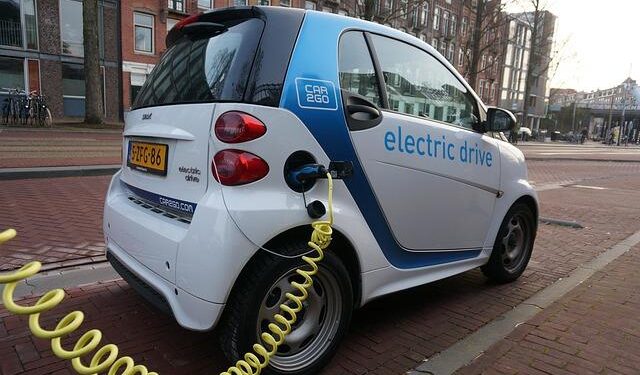Title: Navigating the Future: System Dynamics Modeling of Collaborative Governance in Smart Cities-A Case Study of Dongguan, China
In the rapidly evolving landscape of urban development, smart cities are at the forefront of redefining governance and civic engagement. Dongguan, China-a city known for its robust manufacturing base and remarkable technological advancements-serves as a compelling case study in this arena. Recent research published in Nature unveils a sophisticated system dynamics model that aims to enhance collaborative governance within urban environments. This model offers insights into how various stakeholders, including government officials, businesses, and citizens, can work together more effectively to foster innovation and improve the quality of life for residents. As cities worldwide grapple with the complexities of modernization, the findings from Dongguan herald a new era of urban management, where data-driven strategies and collaborative frameworks are essential for sustainable development. This article delves into the groundbreaking study and its implications for the future of governance in smart cities across the globe.
Examining Collaborative Governance Frameworks in Dongguan’s Smart City Initiative
In the pursuit of creating intelligent urban environments, Dongguan’s smart city initiative stands out through its innovative approach to collaborative governance. This framework involves the engagement of various stakeholders, including government bodies, local businesses, and community members. By leveraging collective input, the initiative aims to enhance decision-making processes, ensuring that the diverse needs and aspirations of the populace are met. Some key elements that facilitate this collaboration include:
- Participatory Planning: Engaging the community in the urban planning process to foster transparency and inclusivity.
- Data Sharing: Establishing platforms for real-time data exchange between governmental agencies and the public, improving responsiveness and accountability.
- Innovative Technology: Utilizing smart technologies to streamline communication and facilitate collaboration across different sectors.
The implementation of these collaborative strategies has shown promising results, particularly in policy formulation and resource allocation. To evaluate the effectiveness of this governance model, dynamic system modeling has been employed, allowing for a nuanced understanding of interactions between various governance actors. The following table summarizes the primary stakeholders involved and their corresponding roles within the initiative:
| Stakeholder | Role |
|---|---|
| Local Government | Policy Maker |
| Business Communities | Investors and Innovators |
| Civil Society | Community Advocates |
| Academia | Researchers and Analysts |
Insights into System Dynamics Modeling: Enhancing Decision-Making Processes
System dynamics modeling serves as a powerful tool in understanding complex systems, particularly in the context of smart cities like Dongguan, China. Through the integration of various stakeholder perspectives, this methodology enables policymakers and practitioners to simulate the effects of collaborative governance on urban environments. Key insights from this modeling process include:
- Real-time feedback loops: Facilitating immediate insights into the consequences of governance decisions.
- Enhanced stakeholder engagement: Promoting collaborative dialogues that are inclusive of diverse viewpoints.
- Scenario analysis: Allowing for the exploration of various outcomes based on different governance strategies.
Moreover, the application of system dynamics in Dongguan reveals the intricate interplay between various factors such as population growth, resource allocation, and technological advancements. These insights are illustrated effectively in the following table, which summarizes potential impacts of governance changes:
| Governance Change | Expected Impact |
|---|---|
| Increased community participation | Higher satisfaction and trust in local government |
| Implementation of smart technologies | Enhanced efficiency in resource management |
| Cross-sector collaboration | Improved service delivery and innovation |
This approach illustrates the capacity of system dynamics modeling to not only inform decision-making processes but also strengthen collaborative governance frameworks, paving the way for dynamic and resilient urban development in smart cities.
Recommendations for Future Growth: Strategies for Sustainable Urban Development in Smart Cities
To foster sustainable urban development in intelligent cities, stakeholders must prioritize collaborative governance as a fundamental strategy. Timely decision-making, effective resource allocation, and community involvement are crucial elements that can enhance resilience against urban challenges. Key strategies for improving governance structures include:
- Establishing clear communication channels among government, private sectors, and citizens to foster transparency.
- Encouraging public-private partnerships to leverage shared resources and expertise in developing sustainable initiatives.
- Implementing data-driven policies that utilize real-time information to efficiently manage urban resources and infrastructure.
Moreover, integrating advanced technologies is essential for optimizing urban planning and service delivery. Smart systems can provide valuable insights into urban dynamics, enabling cities to adapt proactively. Recommended measures for leveraging technology include:
- Investing in IoT solutions that facilitate efficient traffic management, waste management, and energy consumption.
- Developing participatory platforms for residents to contribute ideas and feedback on city projects, enhancing civic engagement.
- Adopting sustainable design principles in new developments to ensure ecological harmony and resource conservation.
To Conclude
In conclusion, the system dynamics modeling of collaborative governance in Dongguan exemplifies how smart city frameworks can be effectively harnessed to address complex urban challenges. As cities worldwide strive for sustainable development, this case study serves as a pivotal reference point, illustrating the intricacies of stakeholder collaboration and decision-making processes. With Dongguan as a trailblazer in integrating technology and governance, other urban centers can look to its example for inspiration. As we move forward, the insights gleaned from this research will undoubtedly contribute to the ongoing discourse on smart city initiatives, paving the way for innovations that enhance urban living and foster collective prosperity. The full study is available in the latest issue of Nature, shedding light on the future of urban governance in an increasingly interconnected world.














Italy to Deport Egyptian Imam After Controversial Comments at Pro-Palestine Rally